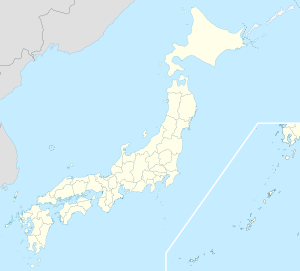Myōkō (village)
| Myōkō-mura (incorporated) 妙 高 村 |
||
|---|---|---|
|
|
||
| Geographical location in Japan | ||
| Region : | Chūbu | |
| Prefecture : | Niigata | |
| Coordinates : | 36 ° 56 ' N , 138 ° 14' E | |
| Basic data | ||
| Incorporated on: | Apr 1, 2005 | |
| Incorporated in: | Myōkō | |
| Surface: | 140.78 km² | |
| Residents : | 4928 (September 30, 2004) |
|
| Population density : | 35 inhabitants per km² | |
| Community key : | 15547-1 | |
| Symbols | ||
| Flag / coat of arms: | ||
| Tree : | Japanese mountain ash | |
| Flower : | Japanese azalea | |
| Bird : | Asian house martin | |
| town hall | ||
| Address : |
Myoko Village Hall 1200 - 1 , OÁZA Sekiyama Myoko -mura, Nakakubiki-gun Niigata 949-2235 |
|
| Website URL: | http://www.vill.myoko.niigata.jp/ ( Memento from March 30, 2005 in the Internet Archive ) | |
Myōkō ( Japanese 妙 高 村 , - mura ) was a Japanese village in Nakakubiki-gun in Niigata Prefecture . In 2005 the village became part of the new city of Myōkō , which is named not after the village but after the mountain of the same name .
geography
In the administrative area of the village were the mountains Myōkō ( 妙 高山 , -san ; 2,454 m), Hiuchi ( 火 打 山 , -yama ; 2,462 m) and Madarao ( 斑 尾 山 , -san ; 1,382 m). The village is named after the former. Rivers are the Seki-gawa ( 関 川 ) and the Doro-gawa ( 土 路 川 ), and as a lake the Numa-no-ike ( 沼 池 ).
history
On March 31, 1955, the Mura joined Sekiyama ( 関 山村 , -mura ), Ōshika ( 大 鹿 村 , -mura ), Toyoashi ( 豊 葦 村 , -mura ) and Haradōri ( 原 通 村 , -mura ), except for its community parts Ōzawa -Shinden ( 大 沢 新 田 ), Ohara-Shinden ( 小 原 新 田 ) and Ōhara-Shinden ( 大 原 新 田 ; except for the Aza (part of the community) Sobutake ( 祖父 竹 )), together to form the new village of Myōkō.
On April 1, 2004, Myōkō joined with the Shi Arai ( 新 井 市 , -shi ) and the Machi Myōkōkōgen ( 妙 高 高原 町 , -machi ) in the Nakakubiki-gun to form the new Shi Myōkō. The name of this city comes from the mountain of the same name. The Nakakubiki gun was then disbanded.
traffic
Myōkō is connected to the JR East Shin'etsu main line to Takasaki or Niigata via Sekiyama Station .
National Road 18 leads through the village to Takasaki or Jōetsu , as well as the Iiyama – Madarao – Arai route of Prefectural Road 97.
economy
Rice cultivation forms a large part of agriculture. The main exports are tobacco leaves and tomatoes.
The main tourist attractions are the hot springs ( onsen ) Seki-Onsen ( 関 温泉 ), Tsubame-Onsen ( 燕 温泉 ), etc. a., as well as the 1,000 m high Madarao plateau ( 斑 尾 高原 , Madarao-kōgen ) with winter sports.

